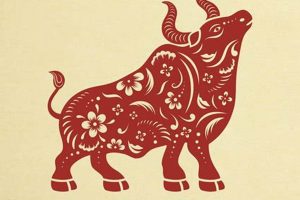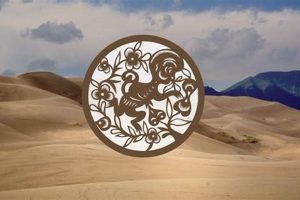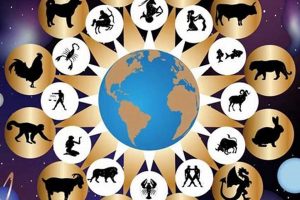In the Chinese zodiac, the year 2014 corresponds to the Year of the Horse, specifically the Wood Horse. This system, a repeating 12-year cycle, assigns an animal and an element to each year, believed to influence the personalities and fortunes of those born within that year. The Wood element adds characteristics of strength, flexibility, and growth to the inherent qualities of the Horse, often associated with energy, independence, and intelligence.
Understanding the Chinese zodiac year provides a cultural lens for interpreting traditional beliefs about personality traits and potential life paths. While not based on scientific principles, it offers a rich symbolic framework that continues to hold cultural significance across East and Southeast Asia. Examining the zodiac year can offer insights into cultural practices and traditions tied to the calendar system and its astrological interpretations. This knowledge can foster intercultural understanding and appreciation for diverse perspectives on time, personality, and destiny.
Further exploration of the Wood Horse’s characteristics, its perceived strengths and weaknesses, and its compatibility with other signs within the Chinese zodiac can deepen one’s appreciation of this complex system. Additionally, examining the historical and cultural context surrounding the Chinese zodiac can offer valuable insights into the enduring power of tradition and belief.
Understanding the Year of the Wood Horse
Individuals born in 2014 are associated with the Year of the Wood Horse in the Chinese zodiac. These tips provide insights into commonly attributed characteristics and potential areas for growth.
Tip 1: Embrace Independence: Wood Horses are often characterized by their independent nature and desire for freedom. Cultivating self-reliance can be beneficial in pursuing goals and navigating life’s challenges.
Tip 2: Channel Energy Wisely: The energetic nature of the Horse can lead to restlessness. Finding constructive outlets for this energy, such as physical activity or creative pursuits, can promote focus and well-being.
Tip 3: Cultivate Flexibility: While strong-willed, adaptability is key. Learning to navigate unforeseen circumstances with flexibility can contribute to greater resilience.
Tip 4: Foster Open Communication: Direct communication is essential. Practicing clear and honest expression can strengthen relationships and prevent misunderstandings.
Tip 5: Harness Inner Strength: Wood Horses possess an inner strength that allows them to persevere through difficulties. Recognizing and utilizing this strength can lead to overcoming obstacles and achieving success.
Tip 6: Seek Continuous Growth: The Wood element signifies growth and expansion. Embracing lifelong learning and seeking new experiences can contribute to personal and professional development.
By understanding the characteristics associated with the Wood Horse, individuals born in 2014 can gain valuable insights into their potential strengths and areas for development. This awareness can promote self-understanding and guide decision-making.
These insights provide a framework for understanding the significance of the Wood Horse in the Chinese zodiac and its potential influence on individuals born in 2014.
1. Wood Horse
The term “Wood Horse” is the direct answer to the query “what year is 2014 in Chinese astrology.” It signifies more than just the animal; it represents a specific combination of animal and element within the Chinese zodiac’s 60-year cycle. This combination occurs every 60 years, imbuing individuals born during a Wood Horse year with specific characteristics attributed to both the Horse and the Wood element. The Horse, known for its vigor, independence, and free spirit, is combined with Wood, representing growth, flexibility, and compassion. This results in the Wood Horse archetype: individuals often perceived as energetic, adaptable, and possessing a strong sense of justice.
The importance of understanding this connection lies in its cultural significance. In many East and Southeast Asian cultures, the Chinese zodiac provides a framework for understanding personality traits and predicting potential life paths. For someone born in 2014, knowing they are a Wood Horse offers potential insight into their strengths and weaknesses. For example, a Wood Horse might be drawn to careers requiring independent work and creative problem-solving. They might also face challenges related to impulsivity or a tendency to become restless. While not definitive predictors of individual outcomes, these characteristics offer a cultural lens through which individuals and their relationships can be viewed.
In conclusion, “Wood Horse” is not simply a label for 2014 within the Chinese zodiac; it provides a complex framework for understanding individuals born in that year. While these characteristics should not be considered absolute determinants of individual fate, they provide valuable cultural context and a potential starting point for self-reflection and understanding the beliefs associated with the Chinese zodiac tradition.
2. Yang Wood
The designation of 2014 as the Year of the Wood Horse incorporates a further nuance: the specific type of Wood, which in this case is Yang Wood. Within Chinese metaphysics, Yin and Yang represent opposing but complementary forces. Yang is associated with activity, outward expression, and growth. Therefore, Yang Wood intensifies the inherent qualities of the Wood element, amplifying characteristics such as expansion, ambition, and assertiveness. This distinction adds another layer of complexity to the Wood Horse archetype, suggesting individuals born in 2014 might possess a particularly strong drive, a proactive approach to life, and a tendency towards outward expression of their thoughts and emotions. This contrasts with a Yin Wood year, which would emphasize more internalized growth, introspection, and flexibility.
The significance of Yang Wood becomes clearer when considering its practical implications. For example, understanding the influence of Yang Wood can provide context for interpreting behavioral patterns. Individuals born in 2014 might naturally gravitate towards leadership roles or fields requiring initiative and decisive action. Their inherent dynamism can be a powerful asset in pursuing goals, but also presents potential challenges. The assertive nature of Yang Wood might manifest as impulsivity or a tendency towards dominance, requiring conscious efforts to cultivate balance and diplomacy. Recognizing this underlying influence can be a valuable tool for self-awareness and personal growth.
In summary, Yang Wood is an integral component of understanding the astrological significance of 2014. It emphasizes the active, outward-focused nature of the Wood element, contributing to the overall characterization of individuals born in this year. While not a deterministic prediction, the understanding of Yang Wood offers valuable insight into potential strengths, challenges, and behavioral tendencies associated with the Wood Horse, contributing to a more comprehensive interpretation of the Chinese zodiac and its cultural relevance.
3. Energetic, Independent
The terms “energetic” and “independent” are frequently associated with individuals born in 2014, the Year of the Wood Horse in the Chinese zodiac. These attributes are not arbitrary but stem from the combined influences of the Horse and the Wood element, providing a framework for understanding personality tendencies and potential life paths. Exploring these characteristics provides valuable insights into the cultural significance of the Wood Horse.
- Drive and Initiative
The energetic nature of the Wood Horse often translates into a strong internal drive and a proactive approach to life. Individuals born in 2014 may exhibit a natural inclination to take initiative, pursue goals with enthusiasm, and readily embrace new challenges. This inherent dynamism can be a significant asset in various aspects of life, from career pursuits to personal relationships.
- Self-Reliance and Autonomy
Independence is a defining characteristic of the Wood Horse. Individuals born under this sign often exhibit a strong sense of self-reliance and a preference for autonomy. This desire for freedom can manifest in various ways, including a tendency to forge their own paths, make independent decisions, and resist external constraints. This independence can be a source of strength but also presents potential challenges in situations requiring collaboration and compromise.
- Restlessness and Impulsivity
The energetic nature of the Wood Horse can sometimes manifest as restlessness and impulsivity. Individuals born in 2014 may find it challenging to remain in static situations or adhere to strict routines. While this dynamism can be a catalyst for innovation and adaptability, it can also lead to impulsive decisions or difficulty maintaining focus on long-term goals. Balancing this inherent energy with mindful consideration is key to harnessing its positive potential.
- Leadership Potential
The combined qualities of energy and independence often create individuals with natural leadership potential. Wood Horses may find themselves drawn to roles requiring initiative, decision-making, and the ability to inspire others. Their dynamism and self-assuredness can be motivating factors for those around them, enabling them to effectively guide and influence groups towards common objectives.
These interconnected facets of “energetic” and “independent” provide valuable insights into the Wood Horse’s character within the Chinese zodiac. Understanding these characteristics offers a cultural lens through which to interpret behavioral patterns and potential life paths of individuals born in 2014. While not deterministic predictors, these attributes offer a starting point for self-reflection and an appreciation for the rich symbolism embedded within the Chinese zodiac tradition.
4. Gregorian Calendar
Determining “what year is 2014 in Chinese astrology” requires understanding the relationship between the Gregorian calendar and the Chinese lunisolar calendar. The Gregorian calendar, the internationally accepted civil calendar, provides a fixed framework of 365 days (with leap years). However, the Chinese calendar, based on lunar cycles and incorporating solar terms, does not directly align with the Gregorian calendar. This distinction is crucial for accurate determination of the corresponding Chinese zodiac year.
- Date Conversion
Converting a Gregorian calendar year to its Chinese zodiac equivalent requires considering the Chinese New Year, which typically falls between late January and mid-February. 2014 in the Gregorian calendar corresponds to the year beginning on January 31, 2014, in the Chinese calendar, placing it firmly within the Year of the Wood Horse. This conversion is essential for accurately identifying the zodiac animal and element governing the year.
- Cultural Significance
While the Gregorian calendar provides a standardized system for international communication and record-keeping, the Chinese calendar retains significant cultural importance in East and Southeast Asian societies. It governs traditional festivals, agricultural practices, and astrological beliefs, including the Chinese zodiac. Recognizing this distinction highlights the cultural context surrounding the zodiac and its continued relevance in contemporary life.
- Time Reckoning
The difference in time reckoning systems underscores the importance of specifying the calendar system in use. Simply stating “2014” requires clarification regarding the calendar being referenced. Understanding this difference prevents misinterpretations and ensures accurate alignment with the appropriate astrological calculations.
- Astrological Calculations
The Chinese zodiac is integral to traditional Chinese astrology, which employs the lunisolar calendar. Calculating birth charts, predicting auspicious dates, and interpreting astrological influences relies on the Chinese calendar. Therefore, understanding the relationship between the Gregorian and Chinese calendars is fundamental to utilizing Chinese astrological principles accurately.
In conclusion, while seemingly a simple question, “what year is 2014 in Chinese astrology” highlights the complexities of intercultural calendar systems and their implications for astrological interpretations. The Gregorian calendar serves as the starting point, requiring conversion to the Chinese calendar to pinpoint the corresponding zodiac year accurately. This understanding underscores the importance of cultural context and the continued relevance of traditional timekeeping systems in shaping beliefs and practices.
5. Chinese Lunar Calendar
The Chinese Lunar Calendar is essential for understanding the answer to “what year is 2014 in Chinese astrology.” It provides the framework for determining the corresponding zodiac year and its associated characteristics. Unlike the Gregorian calendar, the Chinese calendar is lunisolar, meaning it tracks both the moon’s cycles and the sun’s position. This intricate system has cultural and astrological significance, influencing various aspects of life in East and Southeast Asian societies.
- New Year’s Date
The Chinese New Year marks the beginning of a new zodiac year. Its date fluctuates annually, falling between late January and mid-February in the Gregorian calendar. In 2014, the Chinese New Year commenced on January 31st, establishing that year as the Year of the Wood Horse. This variable start date underscores the importance of consulting the Chinese Lunar Calendar for accurate zodiac determination.
- Zodiac Animals and Elements
The Chinese zodiac employs a 12-year cycle, with each year represented by an animal and associated element. These pairings recur in a 60-year cycle. The lunar calendar dictates the animal and element governing a specific year, influencing personality traits and predicted fortunes according to tradition. 2014’s designation as the Year of the Wood Horse derives from this lunisolar cycle.
- Solar Terms
In addition to lunar cycles, the Chinese calendar incorporates 24 solar terms, dividing the solar year into periods reflecting seasonal changes and agricultural practices. These solar terms, while not directly determining the zodiac year, play a role in traditional Chinese astrology and influence auspicious dates for various activities. They demonstrate the calendar’s connection to both celestial observations and cultural practices.
- Cultural Observances
The Chinese Lunar Calendar governs numerous cultural festivals and traditions, including the Lunar New Year celebrations. These observances highlight the calendar’s ongoing cultural relevance and its integration into daily life. Understanding the lunar calendar provides context for these traditions and demonstrates its importance beyond astrological calculations.
In conclusion, the Chinese Lunar Calendar is inseparable from the query “what year is 2014 in Chinese astrology.” It provides the framework for determining the corresponding zodiac year, the Wood Horse. Furthermore, it reveals the intricate interplay between lunar cycles, solar terms, and cultural practices, highlighting the calendar’s continued significance in East and Southeast Asian societies. Understanding its structure and principles is essential for accurate interpretation of the Chinese zodiac and its cultural implications.
Frequently Asked Questions about the 2014 Wood Horse
This section addresses common inquiries regarding the Year of the Wood Horse in Chinese astrology, providing clarity and dispelling potential misconceptions.
Question 1: Does being born in 2014 guarantee specific personality traits?
While the Wood Horse is associated with certain characteristics, individual personalities are complex and shaped by numerous factors beyond the year of birth. The Chinese zodiac offers a framework for understanding potential tendencies, not definitive predictions.
Question 2: How does the Wood element influence the Horse’s characteristics?
Wood adds qualities of growth, flexibility, and compassion to the Horse’s inherent energy and independence. This combination creates a dynamic archetype often associated with adaptability and a strong sense of justice.
Question 3: Is the Wood Horse compatible with other zodiac signs?
Compatibility within the Chinese zodiac is a complex subject. Traditional interpretations suggest the Wood Horse is most compatible with the Goat, Dog, and Tiger, but individual compatibility depends on various factors beyond the animal sign.
Question 4: What are the potential challenges for individuals born in a Wood Horse year?
Potential challenges might include impulsivity, restlessness, and a tendency towards dominance. Cultivating self-awareness and mindful decision-making can help mitigate these tendencies.
Question 5: How does the Chinese calendar determine the zodiac year?
The Chinese calendar, a lunisolar system, determines the zodiac year based on the date of the Chinese New Year, which falls between late January and mid-February in the Gregorian calendar. 2014’s Chinese New Year commenced on January 31st, establishing it as the Year of the Wood Horse.
Question 6: Is there scientific evidence supporting the accuracy of the Chinese zodiac?
The Chinese zodiac is a cultural belief system, not a scientifically validated system. Its value lies in its cultural significance and the framework it provides for understanding traditional beliefs about personality and destiny.
Understanding the nuances of the Wood Horse and the Chinese zodiac provides valuable cultural context. While not definitive predictors, these interpretations offer a framework for self-reflection and understanding traditional beliefs.
Further exploration of Chinese astrology can deepen one’s appreciation of this complex system and its cultural significance.
Conclusion
Exploration of the query “what year is 2014 in Chinese astrology” reveals the intricate connections between calendar systems, cultural beliefs, and astrological interpretations. 2014 corresponds to the Year of the Wood Horse within the Chinese zodiac, a designation derived from the Chinese lunisolar calendar. The Wood Horse, characterized by the combined influences of the Horse’s energetic independence and the Wood element’s growth and flexibility, represents a dynamic archetype. Understanding this designation provides valuable insight into potential personality traits and cultural interpretations associated with individuals born in 2014.
The significance of the Wood Horse extends beyond mere symbolic representation. It offers a framework for understanding cultural beliefs related to personality, destiny, and interpersonal relationships. While not a scientifically validated system, the Chinese zodiac remains a powerful cultural touchstone, shaping traditions and perspectives across East and Southeast Asia. Further investigation into the nuances of the Chinese zodiac and its broader cultural context can foster intercultural understanding and appreciation for diverse belief systems.







